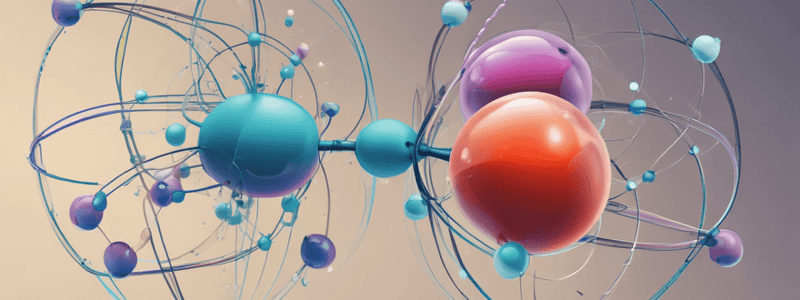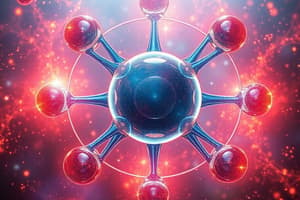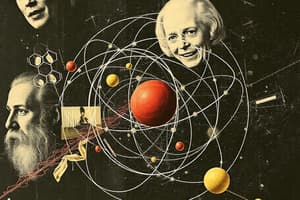Podcast
Questions and Answers
What is the primary mechanism of covalent bonding?
What is the primary mechanism of covalent bonding?
- Electrostatic attraction between atoms
- Transfer of valence electrons between atoms
- Sharing of valence electrons between atoms (correct)
- Repulsion between atomic nuclei
What happens to the atomic orbitals during the formation of a covalent bond?
What happens to the atomic orbitals during the formation of a covalent bond?
- They merge to form a single orbital
- They remain unchanged
- They overlap to form a bonding molecular orbital (correct)
- They are destroyed
What is the optimal distance between atoms in a covalent bond?
What is the optimal distance between atoms in a covalent bond?
- The distance at which electrostatic repulsion is minimum
- The distance at which potential energy is maximum
- The distance at which attraction forces are maximum
- The equilibrium bond length (correct)
What is the shape of the electron density around the nuclei in a covalent bond?
What is the shape of the electron density around the nuclei in a covalent bond?
What is the effect of decreasing the distance between atoms in a covalent bond?
What is the effect of decreasing the distance between atoms in a covalent bond?
What is the distribution of electron density in a covalent bond?
What is the distribution of electron density in a covalent bond?
What is the term for the shared electrons between two atoms in a covalent bond?
What is the term for the shared electrons between two atoms in a covalent bond?
What is the result of two atoms sharing three pairs of electrons?
What is the result of two atoms sharing three pairs of electrons?
What is the energy needed to overcome the attraction between the nuclei and the shared electrons in a covalent bond?
What is the energy needed to overcome the attraction between the nuclei and the shared electrons in a covalent bond?
What is the term for an outer-level electron pair that is not involved in bonding?
What is the term for an outer-level electron pair that is not involved in bonding?
What is the number of electron pairs being shared by a given pair of atoms in a covalent bond?
What is the number of electron pairs being shared by a given pair of atoms in a covalent bond?
What is the maximum number of electrons that hydrogen can achieve in a covalent bond?
What is the maximum number of electrons that hydrogen can achieve in a covalent bond?
What is the primary reason why atoms form chemical bonds?
What is the primary reason why atoms form chemical bonds?
What type of bonding occurs when a metal bonds to a nonmetal?
What type of bonding occurs when a metal bonds to a nonmetal?
What type of bonding involves the sharing of electrons?
What type of bonding involves the sharing of electrons?
What is the key factor in determining the formation of a chemical bond?
What is the key factor in determining the formation of a chemical bond?
What type of bonding occurs when a metal bonds to another metal?
What type of bonding occurs when a metal bonds to another metal?
What is the result of the interactions between nucleus-electron attractions, nucleus-nucleus repulsions, and electron-electron repulsions?
What is the result of the interactions between nucleus-electron attractions, nucleus-nucleus repulsions, and electron-electron repulsions?
What is the primary driving force for the formation of chemical bonds?
What is the primary driving force for the formation of chemical bonds?
Which type of bonding is characterized by the transfer of electrons between atoms?
Which type of bonding is characterized by the transfer of electrons between atoms?
What is the result of the formation of a chemical bond between two atoms?
What is the result of the formation of a chemical bond between two atoms?
Which type of bonding is characterized by the pooling of electrons between metal atoms?
Which type of bonding is characterized by the pooling of electrons between metal atoms?
What is the key factor in determining the type of bonding that occurs between two atoms?
What is the key factor in determining the type of bonding that occurs between two atoms?
Which of the following is NOT a type of chemical bonding?
Which of the following is NOT a type of chemical bonding?
What is the number of valence electrons in an atom of nitrogen in its ground state?
What is the number of valence electrons in an atom of nitrogen in its ground state?
What is the purpose of drawing Lewis symbols for metal atoms?
What is the purpose of drawing Lewis symbols for metal atoms?
What is the basis of the octet rule in chemical bonding?
What is the basis of the octet rule in chemical bonding?
What is the result of the transfer of electrons from a metal atom to a nonmetal atom?
What is the result of the transfer of electrons from a metal atom to a nonmetal atom?
What is the ratio of sodium atoms to oxygen atoms required to form a compound?
What is the ratio of sodium atoms to oxygen atoms required to form a compound?
What is the purpose of drawing partial orbital diagrams in the context of ionic bonding?
What is the purpose of drawing partial orbital diagrams in the context of ionic bonding?
What is the primary assumption of the Lewis model regarding the valence electrons of an atom?
What is the primary assumption of the Lewis model regarding the valence electrons of an atom?
What is the purpose of Lewis electron-dot symbols in the Lewis model?
What is the purpose of Lewis electron-dot symbols in the Lewis model?
What is the underlying principle behind the formation of a chemical bond in the Lewis model?
What is the underlying principle behind the formation of a chemical bond in the Lewis model?
What is the significance of the A-group number in the Lewis model?
What is the significance of the A-group number in the Lewis model?
What is the outcome when two atoms attain stable electron configurations through the sharing or transfer of valence electrons?
What is the outcome when two atoms attain stable electron configurations through the sharing or transfer of valence electrons?
What is the main difference between Lewis structures and molecular orbital diagrams?
What is the main difference between Lewis structures and molecular orbital diagrams?
Flashcards are hidden until you start studying




